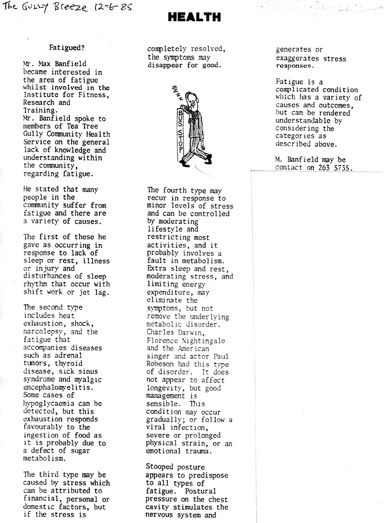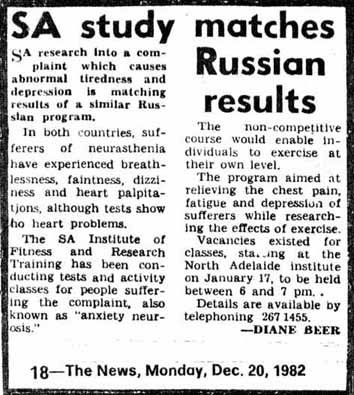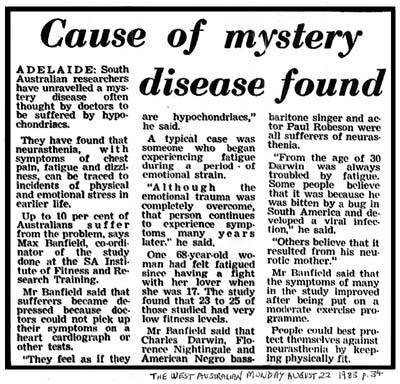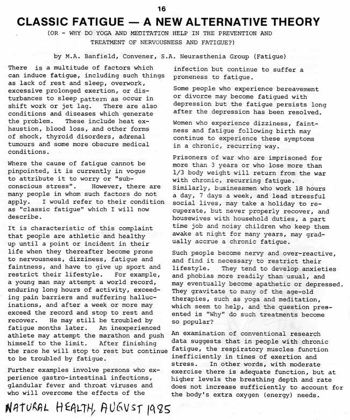Graded Exercise Therapy and PACING for CFS Webpage ©
The real origin of the modern methods of treating the chronic fatigue syndrome with exercise are The Banfield Methods which were developed and proven between 1975 and 1983.
 |
 |
|
My comments on the news items
In 1975 I set about the task of determining the cause and treatment for my own health problems and I found them, partly by enrolling in an exercise program. Seven years later I was asked to develop a method of exercising which would help other patients. The ailments had previously been regarded as having a psychological cause but I was able to determine the physical basis. However, when I discussed the project with a news journalist the articles which were published tended to focus on the previous psychological ideas and examples rather than the actual findings.
Needless to say they were essential for recruiting patients to the project, and for reporting it’s progress and success, so I am thankful for that.
Unfortunately, patients who read them nowadays think that I am writing about a different disease, or a mental illness, which I am not.
Essentially, I determined that patients who have persistent or recurring problems with fatigue generally have an abnormally reduced capacity for exercise, and that in order to gain improvement they need to exercise in a very gradual way, rather than the normal way. It is much more complicated than that, which is why people who try to copy me end up getting different, sometimes adverse results.
Why I developed exercise methods for treating CFS
In 1975 doctors were unable to relieve my illnesses which had been accumulating for several years, so it became obvious to me that I would have to study them myself.
One reason was that when doctors do research it doesn’t matter to them if the disease is cured this year, or next, or in 500, or 1000 years, because they will probably succeed sooner or later, and if they have difficulty solving one problem they can better utilise their time trying to cure another ailment where the solution is easier to determine.
However, I wanted answers in my lifetime, not in centuries into the future.
One of the things I did was to join an exercise program at a fitness research institute, where I was being told to train in the same way as other individuals but that was impossible, so I slowed down and continued at my own rate. I also made many other changes and was able to improve my health, but then I injured my knee and had to stop.
Within the next few years I learned that international researchers were having difficulty getting patients to train for long enough to gain useful information, so when I explained what I had done to the head of that institute, Tony Sedgewick, he asked me to design and organise a project for other patients.
I did that between 1982 and 1983, and the progress and success was widely reported in newspapers throughout Australia where one article stated that it may be a “world first“. in fact, it did become the first time it had ever been done on such a scientific basis and with such success.
Late last year, in November 2012, I learned that a London doctor, named Simon Wessely, had been awarded the John Maddox Prize for his research into the chronic fatigue syndrome and exercise, which looked very similar to what I had been doing, so I investigated the timing.
He started in 1987, only four years after I had already solved the main problems, and the research into that ailment began to surge and expand internationally with the U.S. Centers for Disease Control and Prevention introducing the chronic fatigue syndrome to it’s official list of ailments, and the media reporting it as a “new” disease.
The supposedly “new” methods developed by Wessely and others have been given the labels of “Graded Exercise Therapy”, and “PACING” but the actual details include the basic methods which I used to get patients to train where it hadn’t been possible, or at least not reliable before – namely start low, proceed very gradually, and stay within the level that symptoms don’t cause problems.
However, they haven’t taken all of the details into consideration, so Wessely has received a lot of complaints from patients, and when his colleague, Peter White, completed a five year study of the effects of exercise on 650 patients, called the PACE TRIAL, more than 50% said that they were worse off after the training than when they started.
I have also seen that some patients have copied my methods and found that they are useful, but instead of being grateful to me, they have taken the liberty of pretending that they thought of them. Nevertheless they are still reporting their own “crashes” and “relapses” and countless troubles with the exercise and their illness.
The methods which I developed between 1975 and 1983 were just the beginning, and I have produced much better ways of managing symptoms since then and now have them all under effective control.
When I accused other people of stealing my ideas I expected to get support from honest doctors, researchers, patients and the media, but I am more likely to be told not to make accusations against “supposedly” respectable scientists, or struggling patients, and that if I know more, I should accept the fact that I am just a patient and give the information for free.
I didn’t know what to do about that situation until about a month ago, when I decided to set up a fee structure so that before I publish any more ideas on how to fix those problems I require payment in advance.
(Note: The people who copied me think that the problems were simple and the task was easy, but they will soon learn that it isn’t).
See also why I object to the people who have stolen my ideas and methods here.
A newspaper report of one of my public talks to the Tea Tree Gully Community Health Service, published on 12-6-1985, and another publication shortly after.
 |
|
A local Newspaper report about causes and effects of chronic fatigue
Doctors did not understand my ailments, and could not treat them effectively in 1975, so I began studying them to develop my own methods of treatment. During the next ten years I was writing essays to journals, and letters to newspapers, and setting up self help groups, and giving public talks to make doctors and the public more aware of the problems so that future patients would be better off than I was when I started.
On one occasion I gave a talk to about 30 staff of the Tea Tree Gully Community Health Service where I presented my general conclusions of the wide range of aspects involved in cause etc. A summary of that talk was published in a local newspaper called The Gully Breeze on 12-6-1985, a copy of which I have scanned and provided above left. It can be enlarged to make it easier to read.
I had already completed the research project where I had designed an effective method of exercise for patients with chronic fatigue, and scientifically established the physical basis. It was probably within a year of finishing that study that I set up a self help group for such patients, as can be seen in the article above and to the right, where I was the convener of the S.A. Neurasthenia Group. It was published in a small Natural Health magazine, and I present my summary of some of the causes, effects and treatments for the ailment which I called Classic Fatigue.
Another report relating to chronic fatigue causes and effects in 1985
(not everything goes to plan as expected. I remember joking that if plan A doesn’t succeed move to plan Z, and then start on the Chineses alphabet).
The reason that I set up the group was because, as far as I was aware none existed at that time, and I had many articles published to bring public awareness to the otherwise neglected ailment so that researchers could investigate it, and patients would have a better knowledge of cause and methods of management.
I expected that the researchers might use various biochemical tests, x-rays, and other laboratory methods to confirm what I was saying. In fact that was what happened, and thought that they would thank me for giving them the necessary information and clues about what to look for. However, I didn’t expect them to say that they also thought of the exercise and related energy methods, or that they thought of exercise or oxygen consumption tests, and tilt table tests for diagnosing it, or that they would claim to be the source of my other ideas about cause and effect in order to get massive funding, medical prizes, and a knighthood. I also didn’t expect that some people would describe me as a worthless non-notable fringy kook who was just a sports technician, and imply that I merely spent a short time sitting on a fence and watching a few ordinary tired people run around in circles in one small insignificant research project. To make things worse, I also didn’t expect other individuals to discredit me by saying that it wasn’t reported in the “real” medical literature, or “peer reviewed” medical journals, or to argue that the “evidence” that confirms what I actually did wasn’t good enough???
Nevertheless, if you have a look at all of the research which has been done since then, up to and including to this modern day, you can see a wide variety of people who have made such claims.
It is one of the main reasons I will be charging a fee for any more of my discoveries and essays in advance of publication, and not after, when the same sort of individuals will, I assume, see the opportunity of taking the credit for themselves.
Also, if they wish to make claims to doing anything to solve these problems they will need to do something that I haven’t already done, instead of just copying me.
Of course, I apologise to any honest people who didn’t know what I had been doing, and who feel they have been misjudged by my comments, but I have to defend my intellectual property rights from selfish and unscrupulous individuals who don’t give a dam about me.



